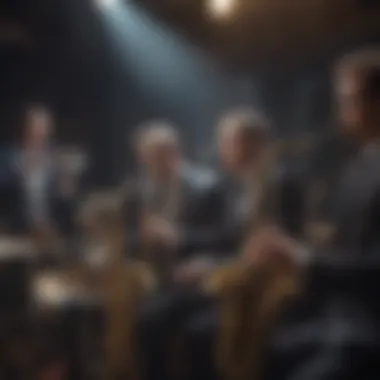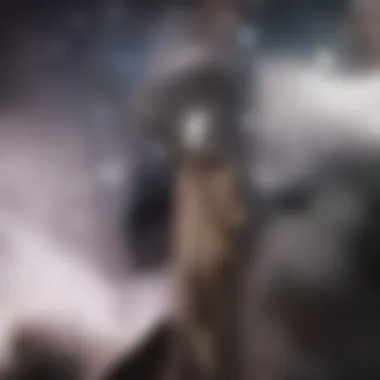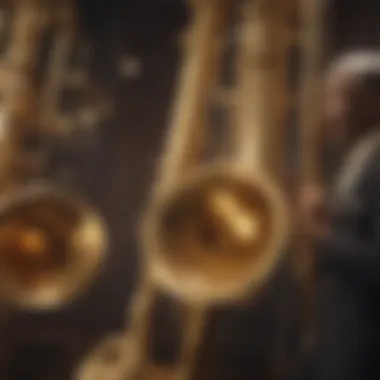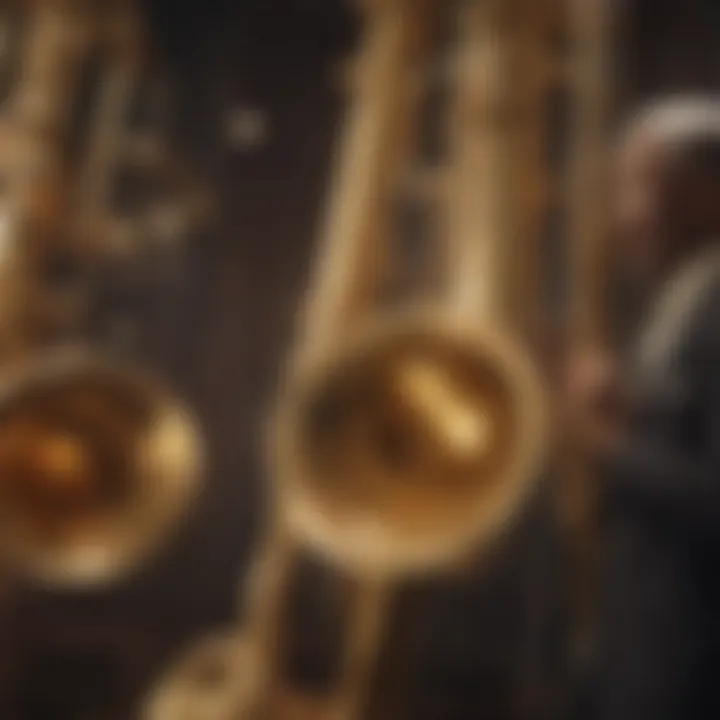Swing Jazz: Its Evolution and Cultural Impact


Intro
Swing jazz represents a transformative period in American music that merged rhythmic complexity with cultural expression. Emerging in the early 20th century, this genre fused elements from various styles, including blues, ragtime, and traditional jazz. As it developed, swing jazz created a unique sound characterized by lively rhythms and improvisation. Its influence can be observed not only in music but also in dance, fashion, and social culture. Understanding swing jazz requires a look into its origins, the societal backdrop of its rise, and the figures that defined its sound.
Understanding Swing Jazz
Understanding swing jazz is crucial as it lays the foundation for appreciating the intricate musical structures and cultural dynamics that have shaped this genre. Swing jazz is not only a form of music but also a manifestation of social change and innovation in the early to mid-20th century. This section aims to elucidate the essence of swing jazz, its defining traits, and its significance within the broader spectrum of American music.
Music is a reflection of the society from which it originates. Swing jazz arose during a period of transformation and upheaval in the United States. Therefore, grasping the definition and essential characteristics of swing jazz enables a deeper insight into its impact and its role in shaping the musical landscape of its time.
Definition and Characteristics
Swing jazz can be defined as a style of jazz music characterized by a strong rhythmic drive and an emphasis on improvisation. The term "swing" itself refers to a rhythmic feel that is infectious and danceable, giving rise to lively performances and popular dance styles of the era. Some of the critical characteristics include:
- Rhythm: Swing jazz often features a syncopated rhythm, which creates a sense of movement and excitement. The rhythm typically consists of swung eighth notes that give the music a characteristic bounce.
- Instrumentation: Swing jazz ensembles generally include a rhythm section consisting of instruments like piano, bass, and drums, and a horn section with trumpets, trombones, and saxophones. This diverse instrumentation adds depth and richness to the sound.
- Improvisation: One of the hallmarks of swing jazz is its emphasis on improvisation. Musicians often take turns to improvise solos, showcasing their creativity and technical skill while contributing to the overall ensemble performance.
"The essence of swing is in its ability to make you move and think at the same time, blending rhythm with complex musical ideas."
Historical Context and Development
The development of swing jazz cannot be understood without recognizing the socio-political landscape of early 20th-century America. The genre took root in the jazz clubs of New Orleans and later flourished in cities like Chicago and New York. Its evolution was influenced by both African American musical traditions and the cultural melting pot that characterized urban American life.
Swing jazz emerged prominently during the Great Depression, a challenging time which paradoxically fueled creativity in music. As people sought forms of escapism, swing jazz became an antidote to despair. Notable figures such as Duke Ellington and Benny Goodman played significant roles in popularizing swing jazz, bringing it into mainstream consciousness. By the late 1930s, it reached the apex of popularity, giving rise to renowned big bands that attracted large audiences.
Understanding the historical context of swing jazz illuminates its lasting impact on music genres that followed. The stylistic developments and innovations in swing set the stage for future explorations in jazz and other music, fostering a legacy that is still felt today.
Origins of Swing Jazz
The origins of swing jazz hold significant weight in understanding how this genre evolved and cemented its place in American music. Exploring its roots offers insights into the cultural and musical environment of the early 20th century. It is essential to see how previous musical styles formed the foundation of swing, how they contributed to its characteristics, and what innovations emerged from these influences. By analyzing these specific elements, we appreciate how swing jazz became a prominent part of the musical landscape.
The Roots in Dixieland and Big Band
Swing jazz did not appear in isolation. Its roots are deeply embedded in both Dixieland and big band music, which flourished earlier in the U.S. Dixieland emerged in New Orleans, marked by a lively ensemble style and collective improvisation. This genre utilized cornet, clarinet, and trombone, creating a vibrant yet cohesive sound.
Key elements of Dixieland include:
- Collective improvisation: Musicians would spontaneously create and respond to one another, contributing to an overall energetic feel.
- Syncopated rhythms: Each instrument played with a sense of urgency, often ahead of the beat. This rhythmic emphasis laid groundwork for swing's characteristic groove.
As the popularity of big band music rose in the 1930s, the structure shifted towards larger ensembles. Bands like those led by Duke Ellington and Count Basie added arrangements and more intricate orchestrations. The balance between individual solos and sectional work became crucial. The 32-bar song form and the standard AABA structure were widely adopted in swing compositions.
The big band era saw:
- Professional orchestras: These groups had more musicians and provided better sound quality. Arrangements became essential, offering a balance between written music and improvisation.
- Increased rhythmic energy: With the swing rhythm, musicians put more emphasis on the off-beat, which captivated dancers and listeners alike.
Cultural Influences and Innovations
The cultural influences surrounding swing jazz were vast and varied. It was the product of a rich tapestry of musical innovations and cross-cultural exchanges. The Great Migration prompted many Southern African Americans to move to urban centers. This migration was crucial for the development of jazz. Cities like Chicago and New York became melting pots where musicians shared styles and ideas.


Key cultural influences include:
- African rhythms: Elements from African musical traditions deeply influenced jazz, particularly in rhythm and improvisation.
- European harmonic structures: Instrumental techniques and forms drawn from European classical music enriched musical complexity in jazz compositions.
Innovations included new techniques in arrangements, which would set swing apart from its predecessors. Musicians began experimenting with the form and style of the music, leading to a more polished production and defining the swing sound itself.
"Swing jazz signified a revolutionary shift. It combined the joy of dance with sophisticated musical elements."
Swing jazz's origins are critical for appreciating its cultural impact. Understanding its roots allows one to grasp the seamless blending of various traditions that made swing thrive. It offers clarity on how the genre evolved into a defining cultural force, one that expertly navigated societal changes and music innovation.
Key Features of Swing Jazz
Understanding the key features of swing jazz is essential not only for appreciating its musical complexity but also for recognizing its profound impact on subsequent music forms. Swing jazz is defined by its distinct rhythmic groove, its unique instrumentation, and its emphasis on improvisation. Each of these aspects contributes to the genre's dynamic quality and cultural significance, fostering a sense of community and shared experience among musicians and audiences alike.
Musical Structure and Rhythm
At the heart of swing jazz lies a complex musical structure that emphasizes rhythm. The most notable feature is the swing rhythm, which is characterized by a lively, syncopated beat where the timing of notes creates a sense of push and pull. This rhythm draws on the triplet feel, where a quarter note is subdivided into three uneven parts, giving it a distinct bounce that encourages movement and dance. The rhythmic patterns create a tension and release that invigorates the listener, making it difficult to remain still.
The arrangement typically includes a strong emphasis on off-beats. Percussion instruments, such as the snare drum, play a crucial role in driving the rhythm forward, while the double bass often lays a foundational groove that supports melody lines. This rhythmic foundation allows soloists to insert bursts of creativity within the framework, leading to exciting improvisational moments.
Instrumentation and Arrangement
Swing jazz is marked by its distinctive instrumentation, which often features a standard big band setup. This includes sections of brass, woodwinds, and rhythm instruments. The trumpet, trombone, and saxophone are integral, often engaging in call-and-response patterns that add to the genre's lively character.
Arrangements are typically characterized by written parts for each instrument, yet they create ample space for improvisation. This balance allows for intricate harmonies and rich textures. Additionally, the role of the piano and the guitar in jazz combos complements the rhythm section's foundation, weaving melodies into the fabric of the performance. The sonic diversity achieved through this instrumentation allows for a unique blend of sounds that defines swing jazz.
"Swing jazz is not just music; it embodies a movement, a lifestyle, and a camaraderie that transcends generations."
Improvisation in Swing Jazz
Improvisation is perhaps the most captivating feature of swing jazz. Musicians often take turns crafting spontaneous solos, drawing upon their intuition and technical skill to produce new variations on established themes. This practice enhances the music's vitality and personal expression. The collaborative nature of these performances fosters a sense of unity among musicians, each adding their flavor to a shared musical experience.
In swing, improvisation is rooted in melody and harmony, encouraging musicians to explore their creativity while remaining anchored to the song's structure. Musicians like Louis Armstrong and Duke Ellington exemplified this, pushing the boundaries of improvisational styles while still maintaining the essence of swing. This spirit of exploration remains an integral part of swing jazz, making it timeless and continuously relevant in today’s music landscape.
Prominent Figures in Swing Jazz
Swing jazz is not merely a genre of music; it is a rich tapestry woven with the contributions of several iconic figures. These musicians shaped the swing movement and left a profound impact on future generations. Their innovative techniques and styles represent the core of what defines swing jazz today. Understanding their contributions allows one to grasp the music's evolution and its enduring legacy in American culture.
Louis Armstrong's Contributions
Louis Armstrong stands as a monumental figure in the realm of jazz. His distinct trumpet playing and vocal style revolutionized the genre. Armstrong introduced a new level of improvisation and expression, combining technical skill with deep emotional resonance. His ability to convey feeling through music transformed not only swing jazz but also the broader jazz landscape.
Armstrong's rendition of "What a Wonderful World" exemplifies his unique vocal style, blending jazz with a wide appeal that transcended racial barriers. His energetic performances brought joy during times of hardship, making him a pivotal figure in popularizing swing music, especially during the Great Depression. Additionally, his collaborations with various celebrated artists helped foster new creative dialogues within the genre.
Duke Ellington's Influence
Duke Ellington, another towering figure in swing jazz, was much more than a bandleader. He was a visionary composer and arranger who expanded the possibilities of jazz music. Ellington's compositions, such as "Mood Indigo" and "It Don't Mean a Thing (If It Ain't Got That Swing)," showcased complex harmonies and orchestrations that elevated the genre.
His orchestra featured a mix of extraordinary talent, each musician contributing to the unique sound of Ellington's music. He pioneered the use of extended forms in jazz, which allowed for intricate narratives in his pieces. Ellington's influence persisted long beyond his time, inspiring countless musicians and composers to explore the artistic potential of jazz.


Benny Goodman and the Swing Era
Benny Goodman, known as the "King of Swing," played a crucial role in the popularization of swing jazz in the late 1930s and early 1940s. His performances helped bring this style to mainstream audiences through concert appearances and radio broadcasts. Goodman's band featured a talented group of musicians, including clarinetist and bandleader whose contributions helped define the sound of swing.
Goodman's famous performance at the Palomar Ballroom in Los Angeles marked the moment when swing became a national sensation. This event catapulted not just Goodman, but swing jazz itself into the public consciousness. His work also broke racial barriers by featuring African American musicians, fostering a more inclusive environment in jazz.
Billie Holiday's Impact
Billie Holiday, a legendary vocalist, infused swing jazz with profound emotional depth. Her unique phrasing and expressive voice left an indelible mark on jazz. Songs like "Strange Fruit" and "God Bless the Child" not only showcased her vocal brilliance but also addressed social issues, blending artistry with activism.
Holiday's ability to interpret lyrics brought new dimensions to swing jazz, influencing many singers who followed. Her style emphasized storytelling and emotion, making her one of the key figures in the genre. Through her life and music, she highlighted the struggles of her time, reinforcing the cultural relevance of jazz.
"The good music can take you places you have never been." — Billie Holiday
The Social Context of Swing Jazz
The realm of swing jazz cannot be entirely understood without examining its social context. This genre flourished during a period of significant economic and cultural upheaval in the United States. The Great Depression, which began in the late 1920s, cast a long shadow over the nation. Despite these challenges, swing jazz emerged as a beacon of hope and a means of escapism. The music provided people with a way to express joy amid despair, creating a connection between performers and audiences that was palpable and profound.
Swing Jazz and the Great Depression
Swing jazz developed in a time when the Great Depression gripped the United States. Economic hardship affected the lives of many, creating a common struggle. During this period, people searched for ways to alleviate their burdens. Music, particularly swing, became a vital outlet.
The rhythm of swing music encouraged dancing and joyous gatherings, offering a respite from the grim realities of life. Big band leaders, such as Duke Ellington and Benny Goodman, found ways to draw in audiences. Their orchestras filled dance halls, igniting social scenes where people could forget their troubles. Swing music symbolized resilience, facilitating camaraderie among diverse groups as they gathered to enjoy life despite the adversities around them.
"Swing music offered more than just entertainment; it provided a collective experience and a means of coping with difficult times."
Cultural Exchanges and Integration
The story of swing jazz is also one of cultural exchange and integration. This genre arose from a melting pot of influences, where African American musical traditions intertwined with various other styles. As swing gained popularity, it played a pivotal role in breaking down racial barriers. Dance halls and clubs welcomed diverse audiences, allowing for shared musical experiences.
Swing jazz also featured prominently in radio broadcasts, reaching households across America. This accessibility promoted a new cultural sensibility. Notably, figures like Benny Goodman became renowned for employing integrated bands. Goodman's willingness to perform with African American musicians was revolutionary, showcasing the genre's ability to foster unity amidst segregation.
The blending of different musical styles enriched swing jazz, allowing regional sounds and unique influences to permeate its fabric. This adaptability not only contributed to the genre's evolution but also solidified its place in American culture, making it a powerful tool for social change and integration.
Swing Jazz in the Media
The influence of swing jazz extended far beyond the confines of nightclubs and dance halls. Its reach permeated popular culture, largely due to advancements in media. Understanding this influence provides significant insight into how swing jazz shaped American social dynamics and music as a whole.
Radio and its Role in Popularizing Swing
Radio emerged as a pivotal force in the dissemination of swing jazz during its golden age. Programs dedicated to showcasing live performances of swing bands helped to popularize the genre among a wider audience. For many, radio provided the first exposure to the innovative sounds of Ellis Regina, Count Basie, and many others.
As listeners tuned into shows like Let’s Dance, they were treated to the rhythms and improvisations that defined swing jazz. Notably, Benny Goodman, known as the "King of Swing", utilized this medium effectively. His broadcasts attracted millions of listeners and transformed him into a household name, effectively propelling swing into mainstream music.
Moreover, the radio enabled a diverse audience to engage with swing jazz, transcending geographical boundaries. This accessibility also gave rise to ongoing conversations about race and culture, as both black and white musicians collaborated in ways previously unseen. The blending of talents on radio created an environment where swing jazz could thrive nationally.
Film and Visual Representation
Film played an equally significant role in the narrative of swing jazz. The 1930s and 1940s saw a surge of movies that incorporated swing music, effectively marrying the auditory culture of the time with visual storytelling. Productions like Swing Time and A Day at the Races featured vibrant performances by iconic artists. These representations were crucial for highlighting the energy and exuberance of the swing movement.


Films often depicted dance scenes featuring swing music, popularizing the dance styles associated with the genre. Audiences were captivated not only by the rhythms but also by the dynamic movements that complemented them. This visual representation helped to solidify swing jazz as an essential part of American culture.
Importantly, films also provided a platform for racially integrated bands to perform together. This served to challenge existing social norms regarding race. The cinema showcased a more inclusive representation of musicians, allowing them to resonate with a broader audience. Consequently, the legacy of swing jazz was intertwined with the evolving narrative of racial dynamics in America.
"The media didn’t just distribute swing jazz—it transformed how the public engaged with music and each other.”
The Decline of Swing Jazz
The decline of swing jazz is a critical chapter in understanding its evolution and lasting impact. During its peak, swing jazz dominated the American music scene, influencing countless musicians and generating widespread popularity. However, as the 1940s progressed, the genre faced significant changes that contributed to its decline, making it essential to examine these factors closely.
The Rise of Bebop and Other Styles
The emergence of bebop in the early 1940s marked a pivotal shift in jazz music. Musicians like Charlie Parker and Dizzy Gillespie sought to explore new musical territories. The intricate melodies and fast tempos of bebop represented a departure from the dance-oriented rhythm of swing. This new style focused on artistic expression and improvisation rather than commercial appeal.
Bebop attracted a different demographic, often appealing more to musicians and jazz aficionados than the general public. As a result, many big bands that once thrived during the swing era began to dissipate. Clubs and dance halls, where swing had reigned, shifted their focus to accommodate smaller combos. This transitional phase highlighted a cultural transformation within the genre, as the audience's tastes evolved and younger musicians sought fresh sounds.
Changing Cultural Landscapes
The cultural landscape of America during the 1940s significantly contributed to the decline of swing jazz. World War II caused socioeconomic shifts that altered how people engaged with music. The war effort shifted the focus of society, leaving less room for the celebratory essence of swing jazz.
Additionally, the post-war period saw the rise of rhythm and blues and rock and roll, which began to capture the public's imagination. These genres introduced new elements that resonated with the changing attitudes of music consumers. The desire for a more straightforward, energetic sound led to a diminished interest in the complex rhythms and orchestrations characteristic of swing.
Legacy of Swing Jazz
The legacy of swing jazz is extensive and multifaceted. This genre not only transformed the music landscape of its own time but also created pathways for modern musical innovations. Its influence permeates various aspects of popular culture today, making an understanding of swing's legacy significant in appreciating its historical relevance.
Influence on Modern Genres
Swing jazz has had a profound impact on several contemporary music genres. The rhythms and improvisational styles pioneered by swing musicians can be identified in various forms of music today. For instance, elements of swing can be found in various genres such as rock and roll, rhythm and blues, and even hip-hop.
- The syncopated beats and lively tempos of swing continue to inspire musicians around the world.
- Notable artists such as Brian Setzer and the Cherry Poppin' Daddies blend swing influences into their works, reviving interest in the genre among younger audiences.
- The fusion of swing styles has also enriched the realm of electronic music, with producers incorporating swing rhythms into their tracks.
Thus, swing jazz serves as a foundational pillar for the musical expressions we encounter today. Its rhythmic complexity and distinctive sound have shaped numerous movements in modern music.
Revival of Interest in Swing Jazz
In recent years, swing jazz has experienced a renaissance, with both musicians and audiences revisiting its rich history. This revival can be attributed to several intertwined factors.
- Nostalgia for Past Eras: Many seek an escape from contemporary pop, which often lacks the instrumental richness that characterized swing.
- Social Dance: The popularity of swing dancing, particularly at social events and dance clubs, has reignited interest in swing music. Organizations often host events where people can experience swing firsthand.
- Media Influence: Television shows and movies that feature swing music or dance sequences have helped introduce this genre to a newer generation, showing its timeless appeal.
- Jazz Festivals: Numerous jazz festivals across the world now celebrate swing jazz, showcasing talented musicians who pay homage to this vibrant style.
As professionals, students, and educators delve into the recordings and performances of swing jazz, they contribute to its enduring legacy. The genre's music continues to evolve, thanks to those dedicated to preserving its core elements while innovating for the future.
Closure
Swing jazz represents a crucial intersection of music, culture, and history. In this article, we have explored its rich evolution, significant figures, and enduring impact on modern music. The genre not only shaped its era but also laid foundational elements for future styles, showcasing a unique blend of improvisation, rhythm, and community engagement. Its importance transcends the mere sound; it is emblematic of a period marked by social upheaval and cultural exchange.
The Enduring Appeal of Swing Jazz
The enduring appeal of swing jazz is evident in its continued relevance and adaptability. Many contemporary artists still draw inspiration from swing's vibrant rhythms and improvisational nuances. This genre has not merely faded into nostalgia; instead, it serves as a source of creativity across various modern musical landscapes. The core elements of swing jazz, like syncopation and the strong backbeat, still resonate in genres such as jazz, pop, and even hip-hop.
"Swing jazz is not just a moment in history; it’s a lens through which we can view the evolution of American music."
Moreover, educational institutions have recognized its importance, often including swing jazz in their curricula to teach the principles of rhythm and improvisation. This commitment to preserving the genre speaks to its significance and the desire to pass it on to future generations.
The community aspect of swing jazz remains strong as well. Dance clubs and social gatherings continue to celebrate and revive swing dancing, illustrating how the music fosters connection and joy among people. Thus, swing jazz’s mix of rich history and lively energy ensures its enduring appeal and relevance in today’s artistic expressions.





